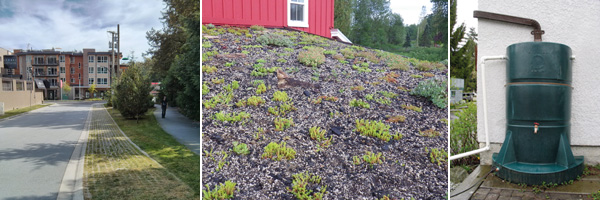An Integrated Stormwater Management Plan (ISMP) combines land use planning, environmental protection, and stormwater management to protect developed lands and natural habitat, while still allowing for long-term urban and economic development.
Instead of simply moving stormwater out of the area as quickly as possible, the primary goals of the ISMP are to reduce the rate and volume of stormwater reaching our creeks and to protect water quality. This is done by integrating stormwater management with land use planning and environmental protection, and by mimicking nature to allow water to seep into the ground instead of running off hard and paved surfaces.
Reducing the volume and speed of stormwater runoff through proactive land use planning and green infrastructure can decrease or eliminate many of the problems associated with traditional development.
Land Use Planning
ISMP combines land use planning with environmental protection and stormwater management. This combination allows land to be developed while keeping in mind the natural habitat. An ISMP approach ensures:
- All watershed values (e.g., fish habitat, recreation, water quality) are considered in land use decisions
- Increased green spaces and pervious areas in all developments
- Development is focused where there is sufficient stormwater capacity
- On-site stormwater detention and management
- No developmentment in sensitive and high risk areas (e.g., in floodplains, and near waterways or steep slopes)
- New design standards are used for stormwater infrastructure, paved surfaces, and new developments
- Enhanced environmental restoration and protection
Technology and Engineering
ISMP utilizes technology and engineering to facilitate the removal of surface water in ways that replicate nature. These measures include the following:
- Pervious paving and infrastructure
Pervious materials allow water to seep into the ground, mimicking soil. This technology can take many forms, from asphalt that water can seep through, to interlocking pavers with space for grass to grow.
- Green roofs
Green roofs serve a number of beneficial purposes: they function to slow down the rate at which rainwater is removed from roofs via gutters; they act as a natural insulator helping to keep buildings cool in the summer; and they provide natural habitat for our urban insects and animals.
- Accounting for future development and climate change
The long lifespan required of infrastructure and development means that we have to plan for what the City and climate will look like many decades in the future, as opposed to that which we have experienced in the past. Climate change will bring more intense rainfall, which will require the City to deal with a significant increase of stormwater.
- Grey Water Reuse
Grey water includes all wastewater generated by residences and businesses other than wastewater from toilets. This includes water from sinks, showers, baths, washing machines and dishwashers. The reuse of grey water requires that it first be captured, reducing the amount and speed of this water back into the environment, then stored for appropriate use at a later date. Rainwater is also a valuable, reusable resource that is wasted when allowed to simply run off our roofs and streets. These sources of water all have the potential to be repurposed for functions including toilet flushing, landscape irrigation and other non-potable uses.
